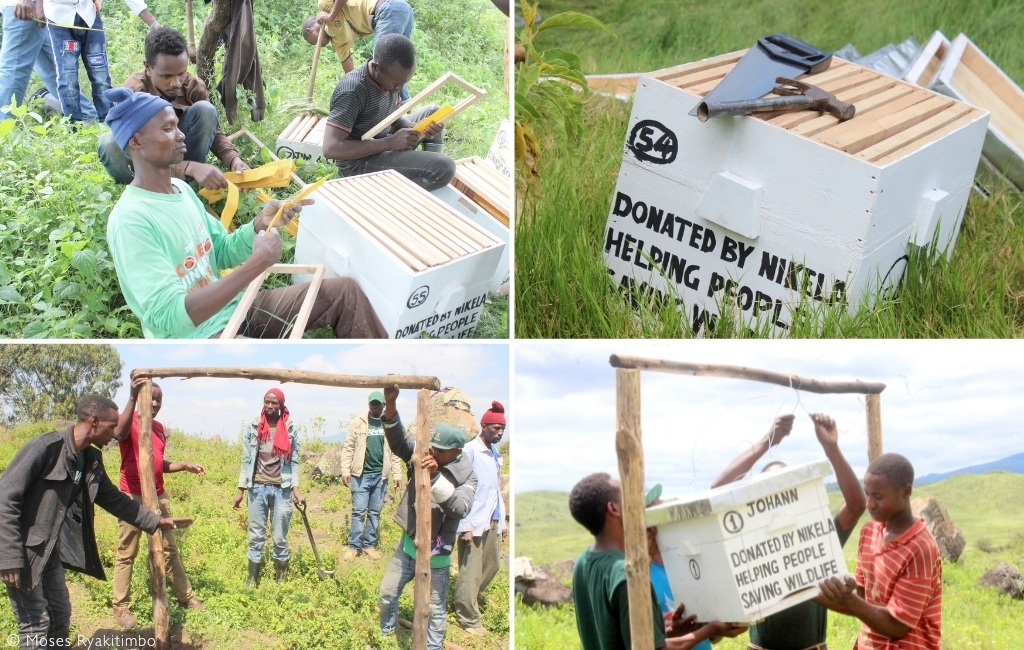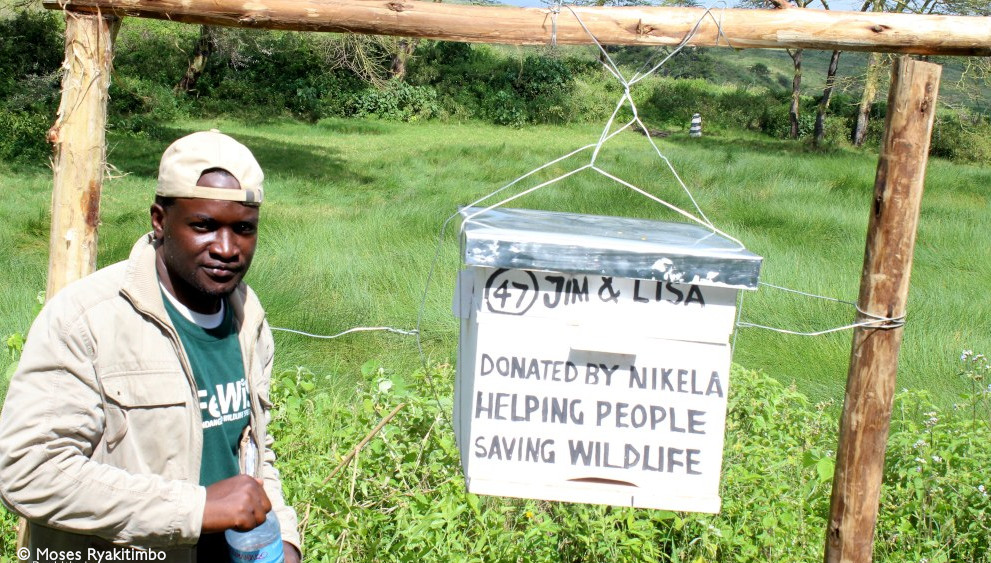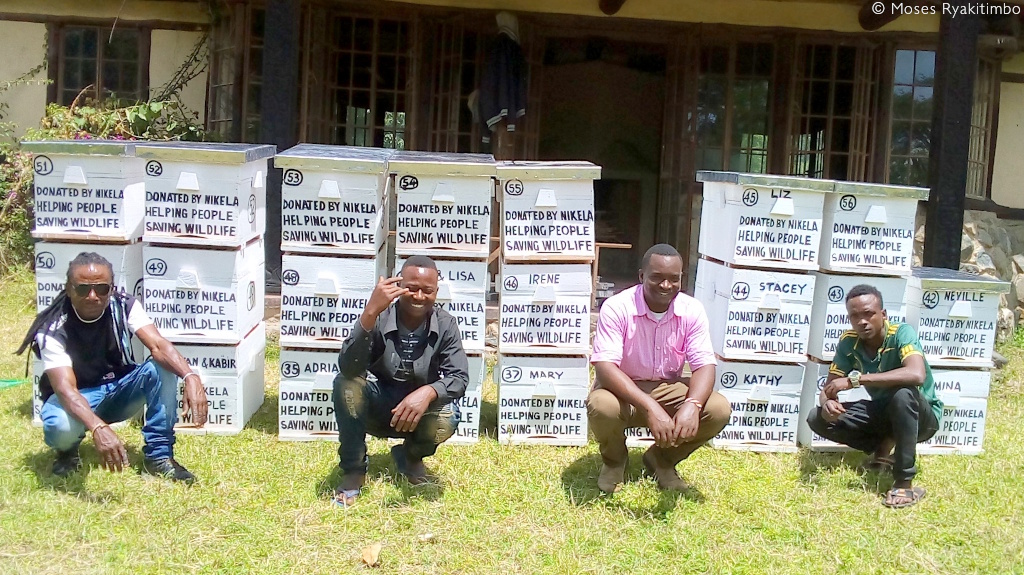Human-elephant conflict is a major threat to African wildlife. Many conservationists and local people are trying to develop innovative, non-lethal solutions that benefit people and elephants.
Imagine a herd of 50 elephants visiting your maize field. This crop is your livelihood. It feeds your family and earns much-needed cash for other necessities. You watch, helpless, as the elephants trample and devour your harvest. Last year the same thing happened. But your neighbour couldn’t stand it. He grabbed a club and chased a huge elephant feasting on his ready-to-harvest maize. It didn’t end well.
Imagine Elizabeth, a subsistence farmer trying to eke out an existence by growing vegetables for her family of five. The rains have been good, she’s toiled in her field, and her plants are growing nicely. Then, one warm summer’s day, an elephant matriarch and her twenty closest relatives come calling. Months of hard work is eradicated. Elizabeth stands there heartbroken. Where once she saw a promising harvest, only a few ragged stalks remain.
Jino Moja
Jino Moja! Mention of the bull elephant called One Tusk spreads fear among the villagers. Mr Gere, a farmer in northern Tanzania, tells of his first encounter with this legendary pachyderm.
“I was inside the house at around eight pm when I heard my wife scream. I took my machete and ran outside. There I saw sugar cane in my farm knocked down. A herd of elephants was inside my farm. I had heard stories about this herd. They invaded a neighbour’s farm and ate half of his maize crops. Everyone knows that Jino Moja is the stubborn one of the herd.
“One farmer tried to chase him away. He was struck by the one tusked elephant. The man went down, and the elephant herd went over him. He was crushed to the bone! In our village, we know better and stay away when we know it’s him.
“So even this night, my machete was no match for Jino Moja. I just stood and watched while they trampled and destroyed my crops.”
Elizabeth and Mr Gere are just two of many farmers living along the border of the Arusha National Park. This reserve is near Arusha, Tanzania’s third-largest city, with a population of over 700,000 (when you include the surrounding sprawl). The national park covers 137 square kilometres and is home to elephants, buffalo, giraffe, antelope, and some leopards.

People vs Elephants
Where humans and wild animals live in close proximity, conflict happens. As human populations expand and wildlife habitat shrinks, the problem grows. This is especially true when villages surround unfenced protected areas. Other than in South Africa, most African protected areas are unfenced and surrounded by buffer zones intended to form a natural barrier between wildlife and farms. However, elephants and other wild animals never got the memo. But then, neither did most farmers whose cattle and goats wander freely through buffer zones into protected areas.
It is difficult to see how human-wildlife conflict isn’t inevitable. After all, you can’t expect an elephant to stay out of a delicious field of maize or sugar cane forever. And, you can’t expect an irate farmer to stand and watch his livelihood being destroyed time and again.

One man, an idea and the humble bee
Fortunately, a young man from Arusha, Moses Ryakitimbo, heard of the plight at Lendoiya village (home to around 1,500 souls). Moses, the founder of Alert for Endangered Wildlife Species (AFeWiS), was already actively engaged in protecting elephants. After interviewing farmers and doing some research, he thought he might have a win-win solution to protect crops and elephants. Not only that, the solution was natural, sustainable and quite simple… bees!
Elephants are afraid of bees. Why? An elephant’s trunk is rich with nerve endings, and this extraordinary sensitivity makes for excruciatingly painful bee-stings. Because of this, elephants tend to stay clear of bee swarms and hives. (Bees have been used in parts of Tanzania for a while now).
Moses learned that by placing beehives to create a fence, one could redirect elephant corridors. In early 2019, Moses approached us at Nikela for support. We funded the pilot project (Phase One) of what Moses envisioned to be a massive beehive scheme. He projected safeguarding multiple village farms around Arusha National Park and other areas where human-elephant conflict occurs.

Phase One – a temporary success
The construction and installation of the first beehives went smoothly. It was surprising how quickly wild bees found the hives. Moses reported that within days of installation, half the beehives had residents. Within a few short weeks, the elephants adjusted their routes, bypassing five farms. The farmers were predictably delighted.
Mr Baraka, one of the first farmers impacted by the bee project, said: “Over 50 elephants used to cross boundaries and destroy food crops like maize, potatoes and banana plantations. Since the beehives were mounted four and a half weeks ago, I have seen a big difference in elephant numbers encroaching.”
This success led to many more requests for hives. Fast forward to mid-2021, and 100 beehives later, farmers are harvesting the best crops of maize, sugar cane, bananas and other vegetables in years.
The human-elephant conflict success didn’t happen without challenges along the way. During a maintenance run, several months after the completion of the ten pilot beehives, problems occurred. One, other insects were finding their way into the hives and negatively impacting the bees. Two, the beehives themselves weren’t holding up structurally.
Moses, ever the problem solver, went looking for solutions. He discovered that a different, more complex beehive design was necessary. The ten original beehives were torn apart. What materials could be salvaged were used to construct replacement hives.

A long-term solution appears to be working
The next 90 hives (completed in several phases) were patterned after the new design. To date, they have remained intact, even when pushed over. Again, Moses is on it. Every month he and his team check each beehive fence. Periodically a beehive is found on the ground, and the support poles need to be reinforced or replaced. The poles supporting each beehive also require regular painting to keep the invading insects away. Grasses and vegetation need to be cleared along each beehive fence. And, most importantly, honey must be harvested regularly. Honey has been a very welcome bonus, not only to eat but to sell.
All in all, the elephants are staying away, and Moses’ mission to protect them is accomplished, at least in this once conflict-ridden area.
Bees bring peace to the land
The individual stories from the farmers say it all:
Mr Elidaima: “We actually didn’t believe that bees could make such a big difference chasing away almost 50 elephants and bringing the number down to zero. We now harvest our food crops in large amounts and live in harmony with elephants.”
Mr Baraka: “Nikela has been a blessing to our village here in Lendoiya. I have witnessed a peaceful coexistence between man and this big mammal called ‘elephant’. Staying in peace with elephants and bees helping out the process. It’s a miracle.”
Elder Balozi: “At my old age, I thank God to have seen this miracle of bees protecting our farms from elephants. We now don’t have elephants disturbing us in the nighttime; we just hear them in other neighbouring villages.”
Mr Nanyaro: “I have ten beehives on my farm…since then I have never even seen elephant dung around…this means elephants don’t come here anymore…this gives me a feeling that elephants are good mammals because they don’t disturb my maize farm anymore.”
Elder Wella: “It’s now almost one year since I’ve seen the one tusked elephant. We plant, we harvest, and we eat what we planted in the soil. Beehives are just a blessing.”
Mr Emanuel: “I am new to the project but very happy to be part of this major accomplishment – seeing elephants stepping out of my farm in a peaceful manner. Thanks to Nikela for supporting us with beehives that keep our crops safe and at the same time protect the elephants from the human-wildlife conflict.”

Building beehives
It takes a specific design to attract the bees and provide the right environment for a colony to thrive. The 100 beehives were constructed and installed in several phases allowing for refinement and calibration along the way.
The hives are professionally built with a shiny metal roof, and the necessary partitions placed perfectly inside for the bees. Each gets a coat of paint and a label. If sponsored by an individual or company, the name is proudly displayed. The completed hives are erected using a system of timber stands and support wires. Within a few weeks, the bees are quietly going about their ‘peacemaker’ duties.
Looking to the future?
With 100 beehives in place, the major elephant corridors through Lendoiya village have been disrupted. Moses has assessed that another 64 beehives will protect the remainder of the village. Eighteen of these are anxiously anticipated by Ester and Tumaini, two adjacent women farmers. In September 2020, three elephants entered their banana plantation, not leaving much behind. Now their maize is growing, and they fear the elephants’ return.

Can this be scaled?
With this human-elephant conflict model proving successful over the past two and a half years, Moses is ready to expand. Most recently, he has had requests from villages surrounding the Tarangire National Park – not too far from the Ngorongoro Crater and the famous Serengeti National Park.
Will this model work anywhere there is human-elephant conflict? Not necessarily. Only where the climate and habitat are suitable for such beehive fences and where wild bees readily populate the hives.
As with many such grassroots projects, the problem is not the ideas, skill or expertise, but funding to operationalise a vision, and even more than that, funding to maintain a project. Moses is off to a grand start. He is knowledgeable, thorough, consistent, admits mistakes and is ready to learn. All traits are essential for long term success.
A final note
We at Nikela have had nothing to do with the plans or designs of this beehive project. It has all been grassroots. We have provided (thanks to individual donors) the funding to make Moses’ dream a reality. (Nikela is an AG Club project partner – visit to donate safely and easily. Please note the Moses (from Uganda) mentioned in the AG club write up is not Moses Ryakitimbo, the designer of the beehive project in Tanzania ).
Resources
Learn more about Nikela and this human-elephant conflict beehive project here
For more info on Moses and his work, click here
For more on Human-elephant confliuct, see here
Learn more about non-lethal interventions to mitigate human-elephant conflict here
To comment on this story: Login (or sign up) to our app here - it's a troll-free safe place 🙂.![]()








